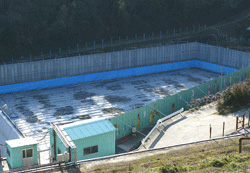About Facilities
Controlled Final Landfill Site
Features
YAMAZEN's controlled final landfill site has functions to retain landfilled waste safely, prevent leachate, and stabilize waste with microorganisms, water, and air. YAMAZEN will perform thoroughgoing control to maintain these functions. Furthermore, in order to prevent odor trouble caused by landfill gas generated during waste stabilization, YAMAZEN uses unique self-combustion deodorization equipment takes proper measures whenever necessary in order to maintain a good surrounding environment.
Outline
| Type | Controlled final landfill site |
| Place | 2441-1 Shidenoki, Hatta, Iga-shi, Mie |
| Installation date | January 18, 1982 |
| Reclamation area | 67,182 m2 |
| Landfill capacity | 1,786,481 m3 |
| Processing type | Landfill (controlled type) |
| Types of waste handled | Types of waste handledCinder, sludge, waste plastics (including asbestos-containing industrial waste), waste paper, wood waste, waste textile, animal and plant remains, waste rubber, scrap metal, glass ceramic waste (including asbestos-containing industrial waste), slag, debris (including asbestos-containing industrial waste), soot and dust, waste specified in Ordinance #13, and hazardous waste such as asbestos |

-
Landfill site
The disposal site is finished with seepage control work, provided with a catchment facility and a water treatment facility, and of construction not to contaminate public waters or ground water.

-
Self-combustion deodorization equipment
Odors are eliminated 99% or more from gas (e.g., fermentation gas or ammonia gas) that is generated from the waste in the deodorization equipment while the waste is in process of stabilization. The equipment incorporates a burner with backfire prevention, thus eliminating the risk of ignition on the landfill site. (Patented No. 3920525)

-
Leachate regulating tank
The leachate-regulating tank retains leachate safely and continues supplying a constant quantity of leachate to a leachate treatment facility. The equipment is designed so that it can respond to an increase in leachate in times of typhoons or during the rainy season.

















